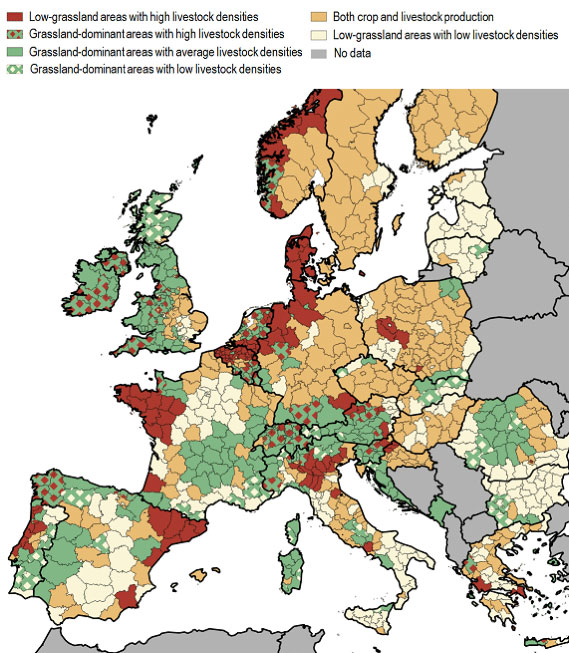What is the average size of a dairy, beef or poultry farm in Europe?
In the EU smaller farms (in economic terms) practice a range of different activities with mixed cropping, mixed livestock, or mixed crop and livestock farming simultaneously conducted. These mixed systems are part of our cultural heritage, and this makes it hard to establish a precise definition of what is the average size of dairy, beef or poultry farms.
Comparison of farm size, financial resources, labour force, or number of animals per farms should be considered cautiously. As statistics on the smallest farm are hard to establish due to mixed systems, public data mostly comes from specialised farms in the top 10 European producing countries.
When considering the type of livestock production on a European map, a limited number of regions can be considered as having a clear specialisation.

Figure 3. Typology of European livestock production areas (Source: INRA based on Eurostat, 2010)[ref]A collective scientific assessment of the roles, impacts, and services associated with livestock production systems in Europe – Scientific Figure on ResearchGate. Available from: https://www.researchgate.net/figure/Typology-of-European-livestock-production-areas-Source-INRA-based-on-Eurostat-2010_fig3_317825615 [accessed 30 Jul, 2019][/ref]
The average size for livestock farms in Europe is below 50 hectares and hosts less than 50 “livestock units”
The “average European livestock farm” uses 34 hectares of agricultural land area and has a herd size of 47 livestock units[ref]http://animaltaskforce.eu/Portals/0/ATF/Downloads/Facts%20and%20figures%20sustainable%20and%20competitive%20livestock%20sector%20in%20EU_FINAL.pdf[/ref]. Even in livestock driven regions, a farm in the European top-10 countries uses 51 ha of land (about 35 football fields), with around 2 people working on the farm, hosting 79 “livestock units”[ref]https://ec.europa.eu/eurostat/statistics-explained/index.php/Glossary:Livestock_unit_(LSU)[/ref] for a total value produced of 138,000 Euros. This first set of statistics from Eurostat shows that we are far from the image most commonly portrayed that the European farming sector is a mass of “factory farms” even in the most specialised and productive countries! European Farms, even in the specialised producing countries, farms remain small when compared to third countries.
Among the specialized farms, those oriented in sheep farming are the largest in terms of surface with about 90 ha, but the smallest in terms of livestock units with an average of 61 and operating capital (less than 113,000 Euros).
Meat-producing farms tend to employ less labour in top production countries in Europe. On the contrary, granivores employ the most manpower (more than 2 people). They also own the largest herds with 312 livestock units, and mobilise the most capital (more than 280,000 Euros). Specialised dairy farms have the second largest herds with about 76 livestock units, mobilise the second highest capital (231,000 Euros) and the second highest level of employment with 1.9 people.
Important differences exist in Livestock “farm size” across Europe
All livestock sectors combined, the United Kingdom, Denmark and France host the largest farms in terms of surface, with roughly 95 ha per farm. Poland, Italy and the Netherlands have the smallest farms, with less than 40 ha per farm, with as low an average as 18 ha in Poland.
Clearly farm size and mobilised capital have no direct link in Europe. Dutch farms are among the smallest according to the farm size criteria but are among the largest in terms of livestock and working capital, along with Danish farmers. In fact, in terms of mobilised capital, Denmark, Netherlands and Belgium are the top 3 countries, far ahead of Germany, the United Kingdom and France for example.